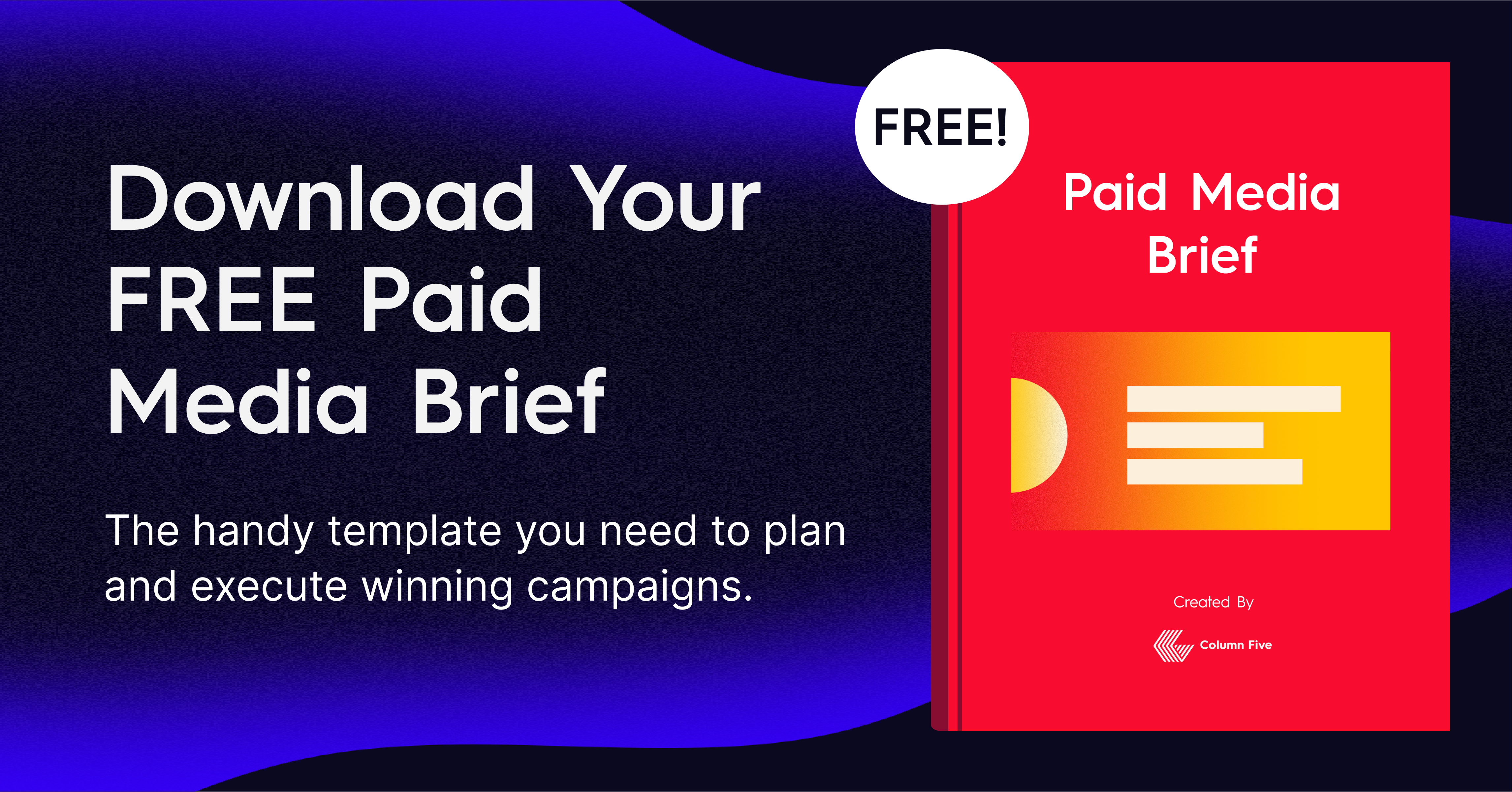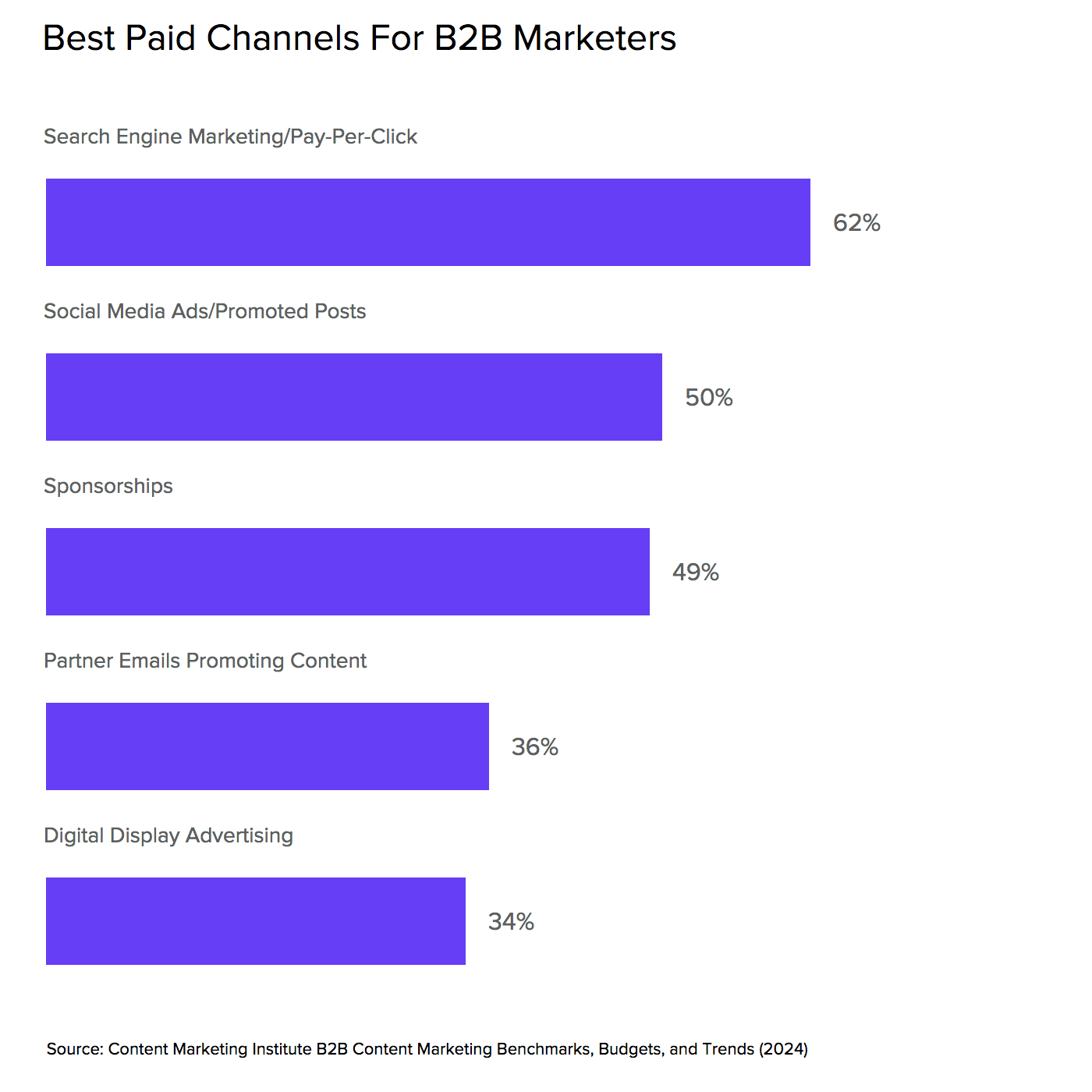Marketing is a tough game, and it’s harder and harder to get the right eyes on your brand. As organic channels become increasingly competitive (especially as AI-generated content has wreaked havoc on SEO), you need a solid strategy to reach the right audience. Enter paid media. With a paid media strategy, you have more power to navigate the algorithms, refine your audience, test the market, and convert the people who are most ready to buy.
But what does paid media entail? Why is it so crucial? And how can you get the most from it? We’re breaking it all down today, along with tips, examples, and a free template to help you build a paid media strategy that works.
TOC
- What Is Paid Media?
- Types of Paid Media Channels
- The Benefits of Paid Media
- Examples of Paid Media
- How to Build a Paid Media Strategy

What Is Paid Media?
There are three types of media channels that can help you get your brand out into the world:
- Owned: These include the channels you, as a brand, already own (e.g., your site, blog, email newsletter, social media).
- Earned: This includes free media coverage, whether interviews, articles, or brand content that is featured or published by a third party (e.g., publications, journalists, social media influencers).
- Paid: Paid media is content that you pay to promote across platforms (e.g., pay-per-click ads, video ads, sponsored posts).
Essentially, if you’re paying for placement anywhere, that is paid media.
Types of Paid Media Channels
There are a ton of paid media channels (and we’ll surely see more in the future). The channels you choose depend entirely on your brand goals and budget. But, in general, these are the most common paid media channels.
- Search Engine Advertising: Includes Google Ads or Bing Ads, pay-per-click ads (where advertisers pay a fee each time their ad is clicked), or search (where you bid on keywords to display your ads in search engine results).
- Social Media Advertising: Includes platforms like Facebook, Instagram, Twitter, LinkedIn, and TikTok, which offer paid advertising options to reach their users. (Note: LinkedIn is particularly important for B2B brands.)
- Display Advertising: Includes banner ads, video ads, and other visual advertisements placed on websites, often targeted based on your audience’s behavior or interests.
- Native Advertising: Ads that appear within a particular platform. They don’t look like traditional ads (aka display ads). They tend to match the type of content that appears on the platform. (Think of an ad that looks like a blog post or Facebook post.) They’re meant to blend into the user’s experience more seamlessly.
- Video Advertising: Video placed within video content, including pre-roll, mid-roll, and post-roll ads on platforms like YouTube.
- Influencer Marketing: Partnering with influencers to promote products or services to their audience, often through sponsored content.
- Affiliate Marketing: Paying partners a commission for driving traffic or sales to your website through their marketing efforts.
- Sponsored Content: Paying to have content published on third-party websites or platforms, usually in a way that resembles regular content but is labeled as sponsored.
- Podcast Advertising: Placing ads within podcasts, often as pre-roll, mid-roll, or post-roll spots.
Note: Different brands favor different channels, but according to the Content Marketing Institute, search engine/pay-per-click ads are the most popular.
The Benefits of Paid Media
While paid media requires an investment of budget, it can help bolster your marketing efforts in major ways, increasing your ROI and impact across the board. Some of the biggest benefits include:
- Targeted Reach: You can target specific audiences based on demographics, interests, behavior, and other factors, ensuring your message reaches the right people.
- Increased Visibility: It helps you increase your brand awareness across channels—especially helpful if you’re a new or niche business trying to compete in crowded markets.
- Fast Results: Unlike organic methods, which are increasingly tough to navigate and take longer to produce results, paid media campaigns can deliver results much faster, letting you see the impact of your efforts in a shorter timeframe.
- Control and Flexibility: Paid media campaigns let you control your budget, track data, iterate, optimize, and improve your content in real time, helping you stay nimble and adjust your campaigns based on performance. (This saves a lot of time, frustration, and money from the jump.)
- Measurable ROI: Platforms have tons of detailed analytics and tracking tools. With AI you also have more tools to synthesize data and get meaningful insights. This helps you concretely measure the performance of your campaigns and calculate ROI.
- Competitive Advantage: Paid media helps you target keywords and audiences your competitors may not be reaching, giving you a leg up.
- Scalability: Paid media campaigns can be scaled up or down based on your budget and goals, allowing you to adjust your efforts as needed to achieve optimal results.
Best of all, paid media can help you supercharge your organic marketing efforts—giving you the best of organic juice with a helpful hit from paid. Ultimately, a healthy marketing operation should blend both to create a cohesive content ecosystem that speaks to people at every possible touchpoint.
Examples of Paid Media
That all sounds nice, of course, but what can a good paid media campaign actually do for you?
Whether you’re looking to attract new recruits or build brand awareness for your new startup, with a strategic plan you can get major results, as we’ve seen over and over through our own client case studies.
- Teach For America is an organization on the frontlines of achieving educational equity. Recruiting capable teachers is a huge part of the organization’s success, but after falling short of their recruitment goals for seven years, they were eager to uplevel their paid media outreach strategy. With a savvy test-and-learn approach, we used industry research and strategic iteration to improve spend, increase ROI, and help them attract the teachers they needed. With this approach, we helped them outperform their goals by 124%.
- Bloomreach is a platform that personalizes the e-commerce experience. In order to scale, they asked us to create a multi-channel paid media strategy to increase brand awareness with new audiences. By using geofencing, historic data, and targeted job titles, we segmented the exact audiences they wanted to reach and partnered with specialized vendors to deploy the campaign across a multi-channel buy (including digital channels, connected TV, programmatic channels, podcasts, and more). These efforts helped them reach 13 million people and beat their goals by 30%.
- Dropbox: Dropbox wanted to attract top tech talent away from giants like Facebook, Amazon, and Google, but they needed to better market their talent brand to potential recruits. After creating a fresh strategy and messaging, we deployed a strategic paid media campaign to reach their audience across platforms. The result? 61% YoY increase in applications supported by paid media and a 7% improvement in market perception.
That said, not all paid media strategies are equal. To get the results you want, you need to approach the process intentionally.
How to Build a Paid Media Strategy
Paid media does require an investment, so if you want the best ROI, you need a strategic plan to hit your goals. Here’s the step-by-step process to follow to ensure your success.
1) Start with a brief.
Whether you plan to implement your strategy in-house or are working with an outside partner, it’s important to know what you’re trying to achieve and what elements you’ll need to deploy your campaign successfully. Start by downloading our free paid media brief.
Your brief should include:
- Objective: What you’re trying to achieve with this campaign (e.g., brand awareness or lead gen).
- Audience: Who do you want to reach? How will you segment them? Consider age, gender, interests, activity, and any other relevant factors.
- Geographic Markets (If Relevant): These could include cities, zip codes, states, or countries.
- Campaign Messaging: What is the key campaign messaging you want to deliver?
- Channels: What are the priority channels you plan to target? Where is your audience most likely to be receptive?
- Budget: How much are you willing to spend, and how will you allocate it? Most platforms use a bidding system, where advertisers compete for ad space based on the amount they’re willing to pay. You may also want to allocate a portion for testing specifically.
- Timeline: Are you running short tests or full-scale, long-term campaigns?
- Format: What type of creative will you produce?
- Additional Info: Any relevant past campaign results or insights that can inform your campaign (if you have them).
Note: It’s important to know what type of infrastructure or tools you might require.
3) Produce your creative assets.
If you want to make the most of your paid campaigns, make A/B testing your friend. That goes for both messaging and creative. Depending on your goals, consider:
- Copy
- Voice
- Visuals (color, imagery, illustration, photography)
- Format (static, motion, video)
- Sizing
Make sure to include a clear call-to-action too.
Tip: When it comes to messaging, use our campaign messaging matrix to ensure you’re telling a cohesive, consistent story across content.
4) Launch and iterate.
You can theorize and plan as much as you want, but you won’t really know how your content works until you launch. You will want to start broad to see what resonates, then continue to iterate and optimize based on your ongoing findings.
Analyze metrics like click-through rates, conversion rates, and return on ad spend (ROAS) to see what’s working. You may also need to refine your audience to improve results.
Note: Creative needs to be in the market for at least 6-12 weeks to see a result. You don’t want to tweak too soon and fix something that was actually working.
Tip: Find out how to run a lean test-and-learn campaign to optimize your spend and results.
6) Report your findings.
Even if your paid media campaign didn’t generate the results you were hoping for, each campaign can provide valuable insights into what does or doesn’t work.
For example, we used a lean paid media campaign to determine whether or not we should build out a separate AI venture. Although our results dissuaded us from doing so, it also gave us helpful insights as to what types of ads and emotional drivers drive CTR with our audience. These insights will continue to help us refine our future campaigns—no matter the goal.
Tip: After each campaign, do a postmortem recap and share your findings with your team. This will help you learn more about your audience and improve your work.
7) Look for ways to work smarter, not harder.
According to Smartly.io, 66% of marketers say managing a growing number of channels and platforms is one of the biggest pain points for digital advertising. Keeping tabs on everything can be overwhelming, but there are all sorts of paid media tools, including AI tools, that can reduce your workload, make your campaigns more effective, and help you maximize your ROI.
Consider ways you can use these tools to assist in every part of the process, including:
- Audience Targeting: AI can analyze vast amounts of data to identify and target highly specific audience segments based on demographics, behavior, and interests, improving the effectiveness of paid media campaigns.
- Ad Personalization: AI can personalize ad content and creative based on user data, making ads more relevant and engaging for your target audiences.
- Bid Management: AI-powered tools can optimize bidding strategies in real time, helping you achieve better ad placements and lower costs.
- Ad Placement Optimization: AI can analyze performance data to determine the most effective ad placements and formats, maximizing your ROI.
- Content Optimization: AI can help optimize ad copy, headlines, and visuals to improve click-through rates and conversions.
- Predictive Analytics: AI can forecast future trends and consumer behavior, helping you make more informed decisions about campaigns.
- Ad Fraud Detection: AI can help detect and prevent ad fraud, ensuring that your ad budget is spent on legitimate impressions and clicks.
- Campaign Performance Analysis: AI can provide detailed insights into campaign performance, helping you understand what is working and what can be improved.
The more you learn to use these tools, the more productive and effective you’ll be.
Tip: See our roundup of helpful AI tools to explore your options, and download our free guide to AI marketing to find out how you can work smarter.
How to Master Paid Media Going Forward
As you dip your toes into the waters of paid media, consider taking an omnichannel approach to gain the best understanding of your audience’s preferences and behaviors.
- Cast a wide net. Test various channels, from search engine marketing ads like Google Search to social media placements and beyond. This will help you gauge audience response across different demographics and interests.
- Track your progress. Monitor key metrics to identify the top-performing channels, and don’t be afraid to remove channels entirely if they prove inefficient.
- Keep iterating. Stay scrappy and flexible—even if your first few campaigns aren’t as successful as you’d like them to be.
- Embrace experimentation. There’s no need to go all out on one channel. Be open to trying new approaches and exploring emerging channels to stay ahead of the curve.
Remember: A broad exploration will generate valuable insights into the platforms that resonate best with your target audience and deliver the strongest returns on your investment.
Once you’ve identified those best-performing channels, you can begin optimizing your presence there and scaling those strategies for the biggest impact.






